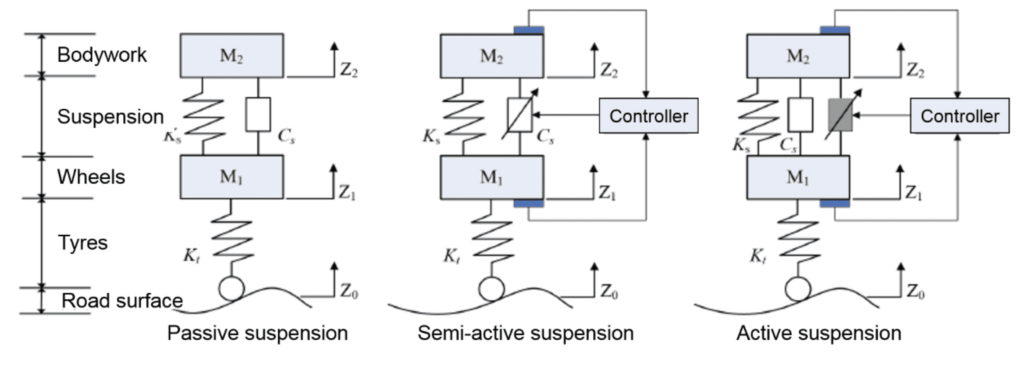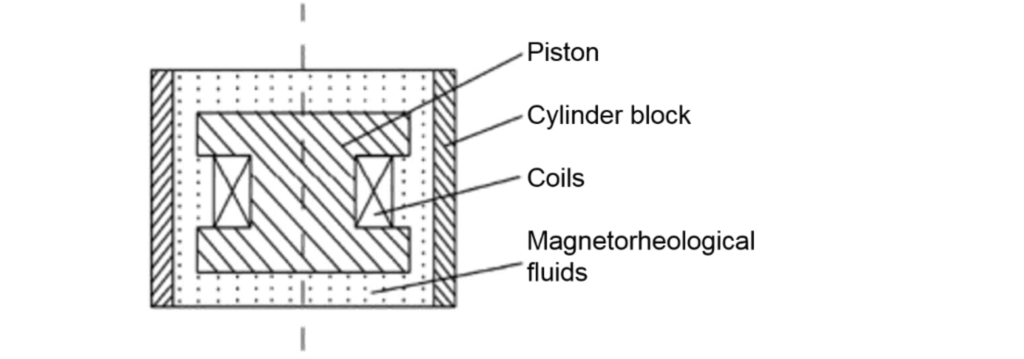With the development of technology and social economy, people also put forward higher requirements for vehicle performance. Suspension is one of the key components to improve vehicle handling and ride comfort. Due to some superior characteristics of semiactive suspension based on magnetorheological damper, the semiactive suspension technology has been pushed to a new height,
which has gradually become the best choice for modern automobile suspension system research. Magnetorheological fluids, as the core material of magnetorheological dampers, have become an important branch in the development of smart materials due to their excellent characteristics such as fast response, simple operation and precise control. When the magnetorheological fluid is under zero-field conditions, it appears as a Newtonian fluid and can flow free. When a magnetic field is applied around the magnetorheological fluid, the viscosity of the magnetorheological fluid instantaneously increases (response time in milliseconds) and transforms to a solid-like or solid state. When the external magnetic field reaches a critical value, the magnetorheological fluid becomes completely solid and exhibits a shear yield stress characteristic of solids, which varies with the external magnetic field strength. The behavior of the magnetorheological fluid is continuous and reversible, and once the applied magnetic field is removed, the magnetorheological fluid instantaneously becomes a Newtonian fluid again, free to flow. This unique property is one of the reasons why magnetorheological fluids are a popular new smart material.
The suspension is one of the key components for improving the handling and ride comfort of a vehicle. The suspension system consists of three main components, including the elastic element, the damper and the guidance mechanism. The dampers quickly attenuate body vibrations, effectively reducing the impact load on the components due to road fluctuations and ensuring body stability during braking, cornering and acceleration. There are three main types of vehicle suspension systems: conventional passive suspension, active suspension and semi-active suspension, Figure 1 illustrates the three different types of suspension systems. The traditional passive suspension system, whose main components are springs with fixed stiffness and dampers with fixed damping forces, can only compromise between the two using optimised design methods for specific road conditions and vehicle operating conditions, and cannot meet the requirements of different road conditions and vehicle driving conditions. The active suspension is a complete or partial replacement of the springs and dampers in a passive suspension by a force generator, which, through the input of external energy, enables the control mechanism to apply a certain control force to the suspension system. Semi-active suspensions consist of springs and dampers with variable parameters, where the damping factor or stiffness of the suspension can be adjusted by inputting a small amount of energy. Theoretical studies and experiments have shown that active suspensions can provide excellent damping performance, change the size of the damping force and spring stiffness according to road conditions and vehicle driving conditions, but they are expensive hardware, complex equipment and consume a lot of energy. At present the mainstream of automotive dampers are still traditional passive dampers, the spring stiffness and damping coefficient of these dampers cannot change with the driving conditions, resulting in a significant loss of comfort and operation of the vehicle.

Fig 1 Automotive Suspension Systems
The magnetorheological damper is similar in structure to a conventional hydraulic damper, with its core components including: outer cylinder, air chamber, piston, piston rod etc. Figure 2 illustrates the principle of operation of a magnetorheological damper. In a magnetorheological damper, an electromagnetic coil is wound around the damper piston and the main working medium is the magnetorheological fluid. The magnetic field is varied by changing the current level of the coil, so the strength of the magnetic field applied in the magnetorheological damper is continuously adjustable and therefore the damping force produced by the magnetorheological damper is also continuously variable.As the strength of the applied magnetic field increases, the viscosity of the magnetorheological fluid also increases, they are positively correlated, if the magnetic field disappears, the influence of the magnetic field on the magnetorheological fluid will also cease to exist, this process is very fast, the control effect of the suspension system with magnetorheological damper is close to the active suspension, while the cost, power consumption, structural complexity, reliability, etc. is better than the active suspension, this will become the best solution for modern automotive suspension system, this will become the best solution for modern automotive suspension system solution, taking semi-active suspension technology to new heights.

Fig 2 The working principle of magnetorheological dampers
The research focus of the magnetorheological damper suspension is divided into three areas, firstly for the design of the semi-active suspension control; secondly for the design of the magnetorheological damper control, and finally for the specific performance requirements of the magnetorheological fluid. The semi-active suspension control system requires real-time monitoring to control the movement of the vehicle when driving. The controller first calculates the damping force that the magnetorheological damper needs to output, and the magnetorheological damper output the damping force, regardless of which part is missing, will directly affect the performance of the vehicle. The magnetorheological damper semi-active suspension is a non-linear and complex system, which is not only influenced by the suspension parameters, vehicle load, road excitation and the external environment, but also by the mechanical properties of the magnetorheological damper (which has significant non-linear and hysteretic characteristics) being influenced by factors such as the external magnetic field strength and excitation frequency, which greatly increases the difficulty of researching the semi-active suspension controller. Research into magnetorheological effects can be traced back to the 1940s, but the application of magnetorheological fluids has been stagnant due to the difficulty of solving problems such as magnetic particle settling and agglomeration stability, sealing technology, and device wear. It was not until the late 20’s that magnetorheological dampers were used in automotive engineering, where Ferrari, Audi, GM and Land Rover were equipped with magnetorheological suspension systems that can respond in real time to road conditions based on signals input from sensors that monitor body and wheel movement to reduce body vibration and increase wheel traction in various road conditions. This can improve the stability of the vehicle while keeping the vehicle speed constant. To ensure the stability of the magnetorheological suspension system over a long period of time, the magnetorheological fluid also need to meet following performance requirements.
1. Better settling stability. The settling stability of magnetorheological fluids is a key factor that hinders the engineering application of magnetorheological fluids, which is also the primary problem to be solved in the development of magnetorheological fluids.
2. Suitable zero-field viscosity. The magnetorheological fluid used in automotive dampers should also meet the basic requirements for viscosity of the damper oil to ensure that the oil has good fluidity and low temperature adaptability.
3. Wider operating temperature. The damper unit is exposed to the environment in which it is located. The automotive damper should not be limited by geographical environmental factors and needs to adapt to all-weather and all-season working conditions.
4. Short response time. The magnetorheological fluid response time is short in milliseconds to ensure the consistency of the magnetorheological damper with its control system.
5. Better sealing adaptability. One of the most difficult problems with magnetorheological fluids at the beginning of their development was the backwardness of the sealing technology, so magnetorheological fluids are required to have good sealing adaptability in order to eliminate leakage and serious corrosion phenomena.
The suspension is one of the key components for improving the handling and ride comfort of a vehicle. Based on magnetorheological damper semi-active suspension, in the design of semi-active suspension control, magnetorheological damper control and magnetorheological fluid control to adjust and meet the practical application requirements, and the magnetorheological suspensions will also become the best choice for modern automotive suspension system research.
